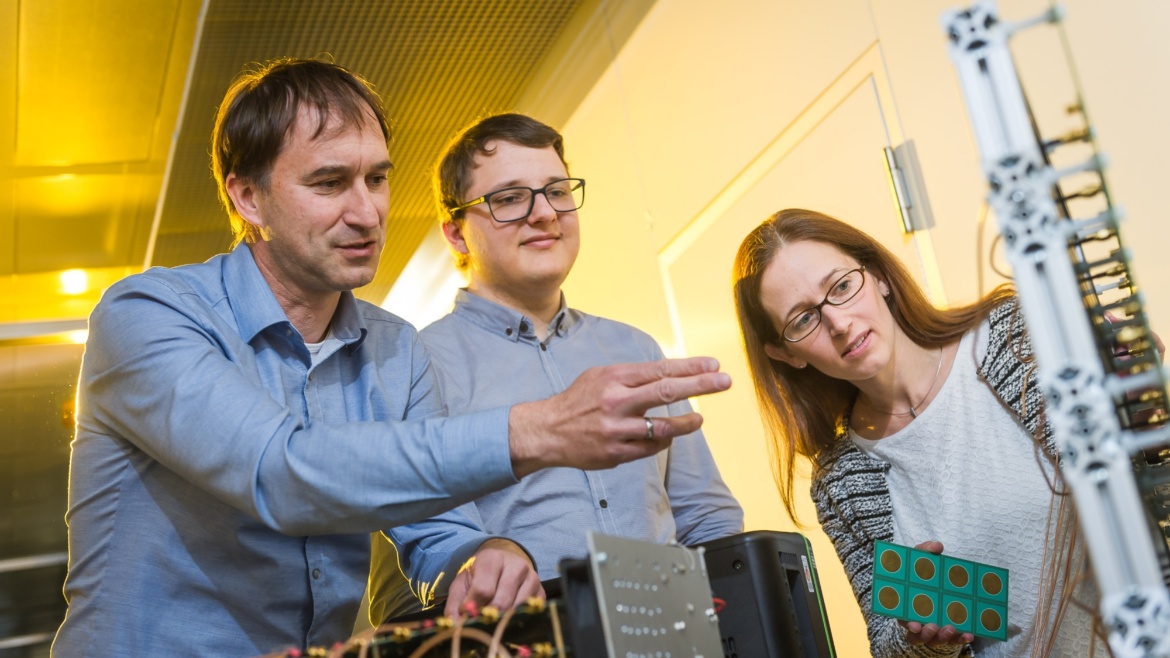
Prof. Stephan ten Brink, head of the Institute of Telecommunications (INÜ) at the University of Stuttgart, and his team of 15 researchers are investigating how artificial intelligence can be used productively in communications technology. He relies on a clever mix of classical mathematics and self-learning methods.
Whether it’s a radio channel, fiber optics or broadband cable network as used by the Internet or cable television, contemporary telecommunications systems all work with classical signal processing methods. “We don't care much about the transmission medium as long as it's suitable,” says Stephan ten Brink, head of INÜ. “We're developing methods to make the most of this medium.” Beyond traditional methods, ten Brink and his team are working with artificial intelligence (AI), which makes the Institute one of the few research institutes in Germany and Europe working in the field of AI processes for the physical transfer layer. The aim of the engineers is to find out where the advantages lie compared to classical, mathematically model-based methods.

Because the physical transmission layer determines the specific conditions of the transmission medium, it is necessary to clarify questions such as: Which disruptions or interferences there are on a specific radio channel? What are the propagation conditions? Which echoes, reflections or diffractions occur? Which variations over time are measurable in the short and long term? “The overall aim is to identify the physical phenomena inherent in each channel. The signal shaping or 'packaging' of the information to be transmitted can then take place using either classical signal processing and coding or with new AI procedures,” says ten Brink, describing the procedure at the Institute. “The bit transmission layer is about error protection and particularly good detection in noise, i.e. noise robustness.” His institute is currently working on developing particularly good transmission methods and is therefore doing important basic work to provide the best possible foundation for scheduling, which involves allocating frequency channels and time resources. Although the Institute also has expertise in scheduling, it focuses on the underlying physical conditions. “The bit transmission layer is about error protection and particularly good detection in noise, i.e. noise robustness.
Exchanging the transmission medium, e.g., by replacing the radio channel with a fiber-optic or cable channel, hardly changes the routing or scheduling in the upper layers,” explains the INÜ manager. “The bit-transmission layer, our sphere of action, is completely different because the physical phenomena are completely different.” For example, dispersion phenomena can be observed with glass fibers, while completely different noise phenomena can be observed with cables.
The overall aim is to identify the physical phenomena inherent in each channel. The signal shaping or 'packaging' of the information to be transmitted can then take place using either classical signal processing and coding or with new AI procedures
Prof. Dr. Stephan ten Brink
Counteracting the flow of impulses
In the chromatic dispersion of the glass fiber, for example, the digital light pulses at the beginning of the fiber can be clearly seen. After 80 kilometers, however, these pulses dissolve, resulting in dispersion or scattering. This happens because the refractive index depends on the wavelength. The various signal components in the optical fiber therefore run at different speeds, which is why they arrive at the receiver at different speeds - the pulse has faded away. As the signal technicians know the properties of the glass fiber very well, they can model a suitable signal processing function according to the known non-linear Schrödinger equation using classical mathematics. Put more simply: they can mathematically determine what they have to do at the receiver to back calculate the dispersion.
This is exactly where AI methods can be used. “These methods are much more generally applicable. They learn the channel, so I no longer have to abstract an exact model, I can just transmit the signal. Together the receiver and transmitter learn what the channel looks like without having an exact model, and can even transmit the signal better,” explains ten Brink. The reason is that “the mathematical model fails to consider many effects that may only occur in the real channel.”
Better performance thanks to AI
His team has set up a radio link at the institute. “We first applied classical signal processing to it and transmitted signals across it. Then we set up neural networks at the transmitter and receiver. It turned out that they could make the transmission quality even better.” Many effects arise that cannot be mapped in the model, but are implicitly exploited. However, it is “not so easy to know exactly what additional structure the neural network has detected via AI,” says ten Brink. In short: scientists at the Institute have so far been able to observe that performance has improved thanks to AI. The disadvantage of this method is, however, that it is currently almost impossible to derive simple rules from the trained net to better understand how exactly the robustness was increased.
But the disadvantage of AI is also an advantage. “The method is particularly interesting for channels with properties that are difficult to model.” In addition, ten Brink provides an idea of where and how AI could be used in the future: “We radio technicians are always concerned with electromagnetic waves - and that is physics. In molecule-based transfer, chemical substances are involved as information carriers and the transfer is much slower.” Sometimes, however, there are combinations of both, for example in nerve pathways. So there are transmission channels that are extremely difficult to model mathematically and therefore difficult to manage using traditional approaches. There might also be a way to make progress with these using AI procedures." So far, however, it has not been clearly clarified that AI is always better he points out.
Susanne Röder
Prof. Dr.-Ing. Stephan ten Brink
Head of the Institute of Telecommunications (INÜ), University of Stuttgart


